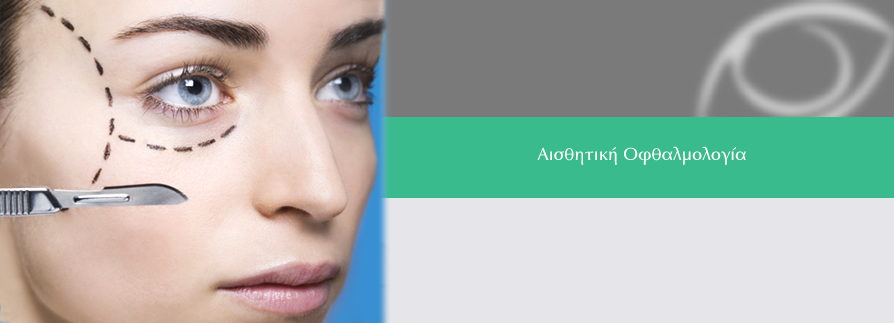
Blepharoplasty
Eyes are the first things that people notice about us, and are an important aspect of our overall appearance. In youth eyelid skin is elastic and smooth, but it thins over time. With loss of elasticity, we begin to see fat that bulges forward. Age, heredity and sun exposure all contribute to this process.
Excess skin and loss of volume in the eyelid area can detract from a healthy appearance. Excess skin hanging over the eyelid area can cause obstruction of vision. Blepharoplasty can provide a more youthful appearance and functional improvement.
What is blepharoplasty
Tired-looking eyes caused by heavy eyelids or puffy, saggy under-eye bags are one of the most common complaints of patients contemplating cosmetic surgery. Blepharoplasty can restore a more energetic and youthful appearance - one should look refreshed, as if he is just back from holiday. Even so, the operation will not remove all wrinkles around the eyes, especially laughter lines.
A blepharoplasty may be performed on the upper eyelids, the lower eyelids, or all four eyelids. It may also be combined with other procedures, such as a droopy eyelid lift (ptosis surgery) and brow lift.
How is blepharoplasty performed
Blepharoplasty is often performed under local anaesthesia, with no need for an overnight stay in hospital. The operation lasts one to two hours at most — less, if only the upper or lower eyelids are being done. You can have additional sedation if you choose.
Upper eyelid blepharoplasty
Cosmetic upper lid surgery (cosmetic upper lid blepharoplasty) is a very popular cosmetic plastic surgery operation to remove loose folds of skin from the upper eyelids.
In upper eyelid blepharoplasty, a fine incision is made in the existing crease above each eye, which minimises the visibility of any scaring. A crescent of excess skin and muscle is removed. In general, Dr Mavrikakis avoids removing fat, unless necessary. The incisions are then closed with fine stitches. These are usually removed within a week.
Lower eyelid blepharoplasty
Cosmetic lower lid surgery (cosmetic lower lid blepharoplasty) is a very popular cosmetic plastic surgery operation to remove loose or excess skin and/or to reduce or reposition fat to improve eye bags. It is much more demanding than an upper eyelid blepharoplasty and requires far more skill and experience to achieve the best result.
Bulging lower eyelids can make even young people look tired, despite the absence of apparent excess skin. Under these circumstances, lower eyelid blepharoplasty surgery is often performed from the inside of the eyelid so that there is no visible scar.
If excess skin needs to be removed, then a fine incision is made in the crease immediately below the eyelash line, extending out into a natural skin crease in order to minimise the visibility of any scarring. When only skin is removed and there is no excess fat, the procedure is known as a pinch blepharoplasty.
What to expect after a blepharoplasty
- After surgery, you will experience some degree of swelling and bruising - cold compresses and elevation of the head will help to relieve any discomfort.
- Bruising may take two or three weeks to disappear completely.
- You should avoid driving for 24 hours after surgery.
- You can return to work if you want but if you deal with the public, you may want to delay your return for around ten days because of bruising and swelling.
- Make-up should be avoided for approximately two weeks following surgery.
- It is preferable to wear dark glasses when outdoors for at least a week.
- Do not swim for three weeks because of the risk of infection.
- Avoid heavy lifting, running or strenuous gym work-outs for two weeks or you may exacerbate bruising or swelling.
- You cannot wear contact lenses for at least 2 weeks after surgery, because the eyelids may be stiff and sore and your eyes may be dry.
- Some people experience blurred vision or sensitivity to light for a few days.
Discomfort is generally mild. Non-aspirin pain relievers are usually all that is necessary post-operatively. Aspirin products, non-steroidal anti-inflammatory medications like ibuprofen, and other blood thinners should be avoided before and after surgery as they may increase the risk of bruising and bleeding.
What are the postoperative care requirements
An antibiotic ointment needs to be applied to the eyelid wounds 3 times a day after cleaning the wounds gently with cotton wool and saline (or cooled boiled water).
Artificial tears need to be instilled 3-4 times a day for the first week for comfort and to prevent any drying of the surface of the eyes. The frequency of the artificial tears is then gradually reduced over the course of the following weeks.
What are the risks of the surgery
Every surgical procedure involves a certain amount of risk e.g. postoperative infection, bleeding, overcorrection.
All precautions are taken to minimise risks but it is important you understand the risks involved. Although the vast majority of patients do not experience any complications, you should discuss them with Dr Mavrikakis.
Aesthetic Ophthalmology
Learn more about Aesthetic Ophthalmology

